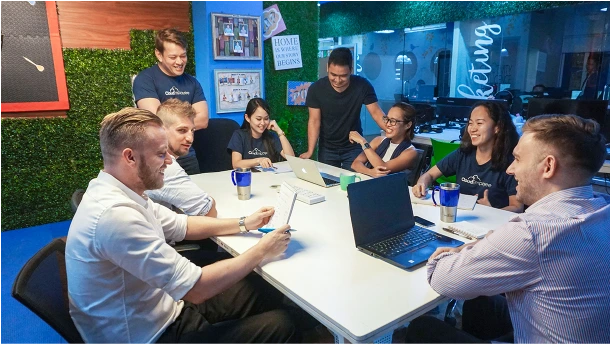How much is the usual rate for Laravel developers?
Presented below is a comparative table of the average annual and hourly local rates of Laravel developers from four different countries. All information on the annual and hourly rates are based on the Neuvoo and Glassdoor sites.
| |
Average Laravel Developer’s Annual Salary |
Average Laravel Developer’s Hourly Rate |
| United Kingdom |
GBP 37,500 |
GBP 19.23 |
| United States |
USD 100,000 |
USD 51.28 |
| Canada |
CAD 93,987 |
CAD 34.02 |
| Australia |
AUD 135,000 |
AUD 69.23 |
To be more cost-efficient on operations and the recruitment process, a myriad of startups and established tech firms are utilising the services offered by IT outsourcing providers.
Here at Cloud Employee, we understand the need for businesses to find alternative solutions that effectively reduce costs and time without sacrificing their expanding operations. To make IT outsourcing in the United Kingdom and throughout the world more accessible, we offer competitive industry rates for hiring the best offshore Laravel developers in the quickest amount of time possible.
For more information about outsourcing developers for your next software projects, here’s a helpful blog about offshore developer rates.
What interview techniques should you use to hire the best Laravel developers?
When interviewing the best Laravel developers, it’s important to always remember that the goal is to assess the potential candidate’s abilities and understanding within the given time.
Here are some helpful and practical tips for interview questions and techniques that you can use to determine the best Laravel developer for you and your software project.
Asks questions that help you effectively evaluate and assess your candidates
It’s important to ask your potential Laravel developer candidates questions that help you evaluate them with a clear objective in mind. Compose your queries in such a way that they assess if the candidates meet and exceed the criteria you have in mind. Based on their answers to your questions, do they align with your company’s value and culture? and do they meet competencies and expectations of the role?
Another crucial thing to remember is to compose your questions in an open-ended format. This will help you assess the candidates' communication skills, and get to know them beyond what is written on their CVs. It’s also important to note the non-verbal cues throughout the interview. Assessing their body language, eye contact, posture, and use of hand gestures gives you an idea of the developer’s soft skills, such as their level of confidence and how comfortable they are being in front of an audience.
Further, it helps to ask about the Laravel developer’s previous projects. Inquire about the technical aspects of their past projects, such as how they were able to maintain the system to run smoothly. Ask them one problem that arose during the project and let them explain how they approached the problem and proceeded to troubleshoot it. This shows the Laravel developer’s in-depth understanding of the technical concepts and how well he/she is able to explain it to a non-technical person in a simplified but understandable way.
Conduct Technical Tests
Testing the potential Laravel developer through technical tests is the most practical and efficient way to assess the depth of their knowledge, experience, critical thinking, and problem-solving skills. It’s highly encouraged to conduct an online programming test as this really helps in hastening the assessment process. It’s always wise to hire someone who is more than qualified at face-value—a Laravel developer who knows how to assess the given situation or problem and thinks it through before they troubleshoot.
Here are some sample questions that you can ask your candidates.
Q: How do you turn off CSRF protection for a specific route in Laravel?
A: To turn off CRSF protection in Laravel, add following codes in “app/Http/Middleware/VerifyCsrfToken.php”
//add an array of Routes to skip CSRF check
private $exceptUrls = ['controller/route1', 'controller/route2'];
//modify this function
public function handle($request, Closure $next) {
//add this condition foreach($this->exceptUrls as $route) {
if ($request->is($route)) {
return $next($request);
}
}
return parent::handle($request, $next);
}
Q: Explain validations in Laravel?
A: In programming, validations are a great way to ensure that your data is always in a clean and expected format before it gets into your database. Laravel provides different ways to validate your application’s incoming data. By default, Laravel’s base controller class uses a ValidatesRequests trait which provides a convenient method to validate all incoming HTTP requests coming from the client. You can also validate data in Laravel by creating Form Request.
Q: What is Eloquent ORM?
A: Laravel’s Eloquent ORM (object-relational mapper) provides a simple Active Record implementation for working with the database. Laravel provides many different ways to interact with your database, and Eloquent is most notable of them. Each database table has a corresponding “Model” which is used to interact with that table. Models allow you to query for data in your tables, as well as insert new records into the table.
Q: Explain what facades are in Laravel.
A: A Laravel facade provides a static-like interface to services that are in the application’s service container. Laravel self-ships with many facades which provide access to almost all features of Laravel’s. Laravel facades serve as “static proxies” to underlying classes in the service container and provide benefits of a terse, expressive syntax while maintaining more testability and flexibility than traditional static methods of classes. All of Laravel’s facades are defined in the Illuminate\Support\Facades namespace.
Q: What is database migration? How is it used to add/insert initial data to the database?
A: Migrations are like version control for your database, allowing your team to easily modify and share the application's database schema. Migrations are typically paired with Laravel's schema builder to easily build your application's database schema.
Laravel includes a simple method of seeding your database with test data using seed classes. All seed classes are stored in the database/seeds directory. Although seed classes may have any name as you wish, it is advisable to follow some sensible convention, such as UsersTableSeeder, etc. By default, a DatabaseSeeder class is defined for you. From this class, you may use the call method to run other seed classes, allowing you to control the seeding order.
Q: What is HTTP middleware?
A: Middleware provides a convenient mechanism for filtering HTTP requests entering your application. For example, Laravel includes a middleware that verifies if the user of your application is authenticated. If not, the middleware will redirect the user to the login screen. However, if the user is authenticated, the middleware will allow the request to proceed further into the application.
Of course, additional middleware can be written to perform a variety of tasks besides authentication. A CORS middleware might be responsible for adding the proper headers to all responses leaving your application. A logging middleware can help log all incoming requests to your application.
There are several middlewares included in the Laravel framework, including middleware for authentication and CSRF protection. All of this middleware are located in the app/Http/Middleware directory.
Q: How do you create a controller in Laravel?
A: The syntax used to create a controller in Laravel is as follows-
<?php
namespace AppHttpControllers;
use AppUser;
use AppHttpControllersController;
class UserController extends Controller
{
/**
* Show the profile for the given user.
*
* @param int $id
* @return View
*/
public function show($id)
{
return view('user.profile', ['user' => User::findOrFail($id)]);
}
}
How can Cloud Employee help you?
Cloud Employee is a UK-managed IT outsourcing service provider that connects startups and tech companies from across the globe and assists them in venturing into promising possibilities and growing their enterprises further. Here at Cloud Employee, we help connect our partner companies to the best offshore Laravel developers here in the Philippines.
To start, simply contact one of our account managers and send us your staffing requirements. Our team of recruitment officers will conduct a local search with your specific preferences for skilled Laravel developers, and suggest a shortlist of the best and most qualified candidates. From that list, you get to personally handpick whom you want to interview and evaluate the level of their technical skills. Once you're satisfied with the assessment, you can choose which of the Laravel developers will board your offshore team.
Your selected offshore development team works solely for you and your company at your preferred time as if they were a part of your in-house project team. This assures the effectiveness of your offshore Laravel development team.
As your outsourcing partner, our services do not stop at the recruitment process. We assure that your offshore Laravel developers are provided with complete IT support, the required hardware, software, and fast internet connectivity here at our modern offices and guarantee your offshore development team gets the work done. Here at Cloud Employee, we handle all of the administrative and back-office tasks, such as general Human Resources and admin matters, licensing permits, and payroll taxes so you can prioritise managing and running your team, and your company’s growth.
What is the dedicated hiring model?
The Dedicated Hiring Model smoothly assimilates the dedicated offshore team you selected with your existing in-house development team, further reducing the possibility of any miscommunication and enabling your offshore Laravel developers to become a part of the project’s design and infrastructure.
Because of its flexibility, it is considered as one of the best engagement models. With this model, you and your team can request for tech talents, resources and types of equipment at any given time corresponding to the current requirements of the project. The Dedicated Hiring Model allows the in-house team to scale up or down with relative ease.
It’s also important to note is the payment method is made easier and simplified for you; you would only have to pay once and this one-time fee already includes the offshore team members’ monthly salary and the outsourcing provider’s service fee.
Pros
- Perfect for long-term projects, especially those with constantly changing project scopes and undefined specifications.
- Predictable budget despite an indefinite project scope.
- You will have complete access and control over the whole recruitment process, selection of candidates, and management of the offshore development team.
- Product quality can be monitored, assessed and guaranteed.
- The offshore team gains more in-depth knowledge and understanding of your objectives, goals, standards, and expectations.
- The offshore team exclusively works for you throughout the project scope.
The Dedicated Hiring Model is perfect for businesses that:
- Prefer to work with dedicated Laravel developers for their current and upcoming future projects.
- Need to reduce expenses in terms of talent search and recruitment process.
- Require flexibility in a team’s workload and scalability, especially during the project’s development.
At Cloud Employee, your dedicated team of Laravel developers works solely for you and mirrors your preferred working hours. This means that both you and the offshore development team can work together at the same time, and in turn, reduce any miscommunication issues and foreseeable inconveniences. Your offshore Laravel team also uses your preferred software, tools, and standards, making them a more effective part of your team.
Combining the Dedicated Hiring Model and Cloud Employee’s extensive experience in the IT outsourcing industry, our team came up with a business model that is truly unique and effective. This business model has simplified the recruitment process, made working practices more flexible, and bridged the gap between in-house and offshore teams, all at competitive industry rates.




















